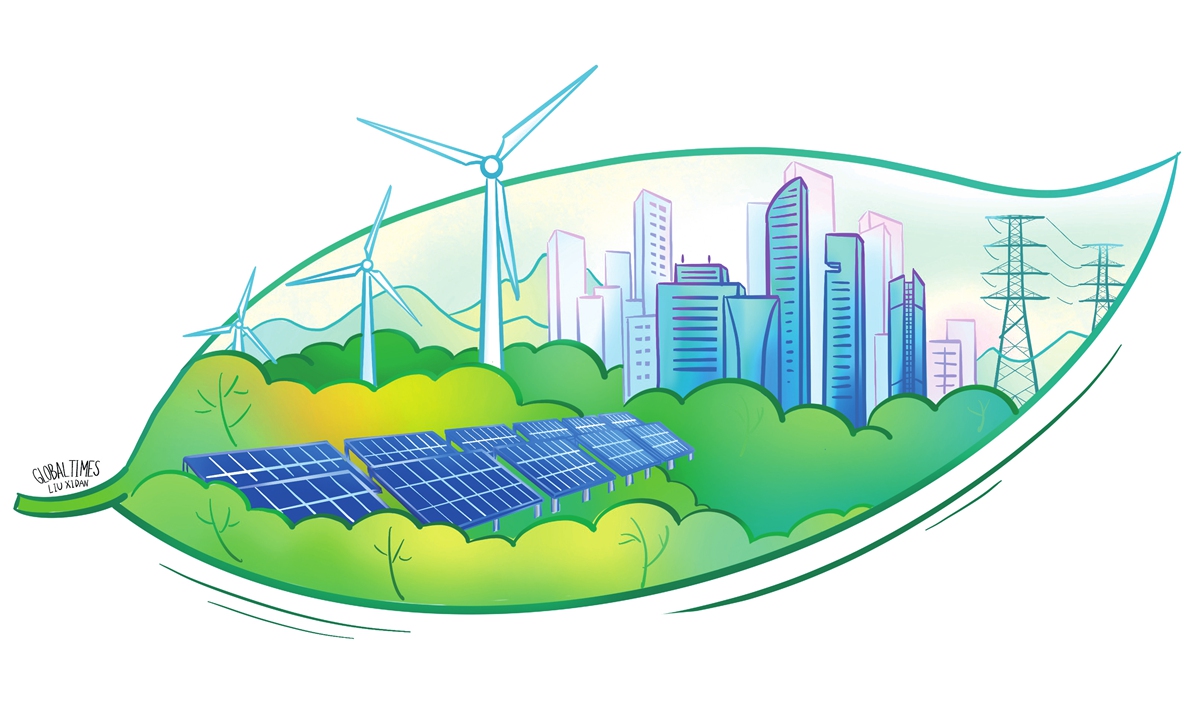Ningxia an epitome of China's green transition

Illustration: Liu Xidan/GT
Recently, I had the opportunity to explore the Liupanshan Mountain in northwest China's Ningxia Hui Autonomous Region. Shortly after departing from Yinchuan, the capital of the region, we encountered extensive stretches of solar photovoltaic panels and clusters of windmills lining both sides of the highway.
It is worth noting that this form of power generation has emerged as a crucial economic asset for the western region.
In the past, Ningxia was known for its specialty products, such as sheepskin, wolfberries and Fat choy, but now it has become an important source of electricity for the whole country. One recently launched project is the "Ningxia Electricity to Hunan," which transmits mainly clean electricity from Ningxia to central China's Hunan Province.
The Ningxia wind and solar power transmission line spans 1634 km, from Ningxia, traversing Gansu, Shaanxi, Chongqing, Hubei, and terminating in Hunan. The project boasts a designed transmission capacity of 8 million kilowatts and a total investment of 28.1 billion yuan.
The Western media has recently focused on rising coal-fired power projects in China. They thought this may hinder China's commitment to peak carbon dioxide emissions by 2030 and achieve carbon neutrality by 2060.
These sorts of projects in Ningxia are a clear response.
Regarding China's geography, the northwest is best suited for wind and solar projects, like the Helan Mountain region and the Tengger Desert in Ningxia. However, these areas are sparsely populated, with little industry and are far from the coastal and southeastern regions, where electricity is most needed.
How can we ensure wind and solar power transmission remains uninterrupted?
According to a friend who works in the electricity industry, the amount of coal power generated in Ningxia has stayed the same over the past two years. However, newly constructed or renovated coal power projects are being implemented as complementary measures to ensure uninterrupted power transmission along ultra-high-voltage lines to other areas far away from Ningxia.
The project in Zhongwei city, Ningxia, which is involved in the transmission of electricity to Hunan, is to build a power photovoltaic base while at the same time bundling clean, efficient, advanced, energy-saving coal power in the neighborhood to achieve uninterrupted transmission.
A closer examination of China's grassroots efforts in transitioning to energy efficiency helps us understand why China will fulfill its promises.
Once one of the most impoverished regions in China, the Liupanshan mountainous area in Guyuan city, Ningxia, has undergone a remarkable transformation. It has emerged as a renowned scenic destination, boasting a network of bicycle paths stretching over 50 kilometers. These paths provide a convenient means for visitors to explore the picturesque landscape, meandering amidst the lush hills and serene waters.
I walked into a village snack shop and saw that the cookers had been converted into electric stoves. I asked the shopkeeper what she relied on to keep warm in winter. She mentioned that her family was preparing to use electric heaters this winter.
The heating season in Guyuan lasts five months in winter, and while farmers used to burn wood and coal to heat their homes, they are now expanding their use of electricity, natural gas and solar energy. According to Guyuan's plan, by the end of 2024, the clean heating rate in urban areas will reach 100 percent and 60 percent in rural areas.
The shopkeeper also told me that heating with electricity or natural gas is cheaper than burning coal. According to local farmers, burning coal stoves requires at least 5 tons of coal in winter, and at an average price of 1,200 yuan per ton, it costs about 6,000 yuan; after the switch to electricity, the average monthly electricity bill is about 700 yuan. According to government regulations, households that switch from coal to electricity, coal to gas, or coal to solar energy to heat their homes receive a specific subsidy.
The changes in Guyuan are a microcosm of the world's most significant and ambitious emissions reduction program. When every village and city in China follow this plan to achieve their emissions reduction targets, China will show the world that it is not just reducing emissions but that this emerging economy is creating a new path for human development.
Next, the Chinese will prove to the world that we can not only produce the chips that the Americans are desperately trying to contain, but we can also walk a different path to sustainable development different from the 500-year expansion of the West.
The author is a senior editor with People's Daily, and currently a senior fellow with the Chongyang Institute for Financial Studies at Renmin University of China. dinggang@globaltimes.com.cn. Follow him on Twitter @dinggangchina



